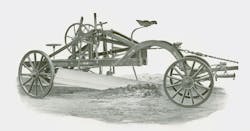The pull grader was the standard machine for road maintenance from the mid-1800s until motor graders rendered them obsolete in the 1930s, and several elements factored into their design:
Drawbar. The drawbar conveyed the pulling power from the stock or tractor that moves the machine to the blade. Direct draft, the application of all tractive effort solely to the moldboard, was the ideal.
Frame configuration. There were two basic types: arched and straight. The arched frame combined maximum strength and blade clearance with minimum weight, while the straight frame was most effective at conveying pulling power directly to the moldboard. Some frames combined elements of both designs.
The Historical Construction Equipment Association (HCEA) is dedicated to preserving the history of the construction, dredging and surface mining equipment industries. Information on programs and membership: www.hcea.net, 419.352.5616 or [email protected].
Moldboard: Stock blade length carried by most manufacturers ranged from 6 to 12 feet. Some offered 14-foot blades as a special order; Galion produced a 14-foot grader as a stock product, and Adams and Caterpillar offered 16-foot maintenance blades as an option for select machines. The first grader blades were merely flat boards, but concave blades that quickly rolled the material out of the cut became the standard. The abilities to side-shift the blade and to swing it out and up followed over the years, but like the concave blade, nothing is known of the origin of these concepts.
Weight. Too heavy a grader exacted a harsh toll on the motive power, be it stock or mechanical, and could subject the grader to damaging stresses between the tractive effort exerted on it and the combined weights of the grader and load. Too light for the work to be done, and the operator could lose control as the blade was forced away from the load. The grader had to move as much material as efficiently as possible while staying with the load with minimal machine weight. The advent of the traction engine, and then the tractor, made larger and much heavier graders possible.
Rear axle. Wider rear axles made for greater stability in heavy going, and on many models the rear axle could be extended. The American Champion, the first true four-wheeled pull grader, was also the first grader with an adjustable rear axle.
Ease of operation. Graders used a range of devices to control the blade, such as levers, hand wheels, pedals and, later, hydraulics and small gas engines. There were also various means of conveying the action of the controlling mechanism to the blade, including direct linkage, rack and pinion, beveled or worm gears, and cams.
Tightness of construction and machining. Lost motion that introduced play into the moldboard was the bugaboo of grader design. Along with causing loss of control and producing a rough grade, this also caused stress and damage to the grader. Graders had to be constructed with more than enough strength to handle the load without yielding.
Application. There were two basic types of pull graders. The larger and more robustly built machines were intended for ditching, road construction, heavy grading, and the like; smaller and lighter graders were designed for road maintenance. The latter graders were often called patrols, a term arising from the patrol system of road maintenance: A patrolman was assigned a beat, consisting of a given section of road, and he used a light grader that he often provided himself to keep it in good repair through a regular schedule of passes, usually without engaging in ditching or heavy grading.
Power ratings. Grader literature often recommended the appropriate power supply, either in horses or tractor horsepower, for the machine in question.





